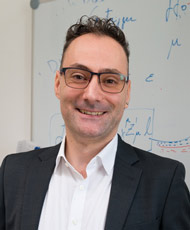
Gianluca Inguglia
Junior Group Leader
Belle
Contact
Email: Gianluca.Inguglia(at)oeaw.ac.at
Telephone: +43 (1) 51581 - 2828
Location: Postsparkasse
Room: 3rd floor
Biographical sketch
Positions
- Since 2020 Junior Group leader
- From 2017 HEPHY postdoc, Wien (Österreich)
- From 2014 to 2017 DESY postdoc Fellow, Hamburg (Deutschland)
Education
- 2014, PhD degree in Physics, Queen Mary University of London (United Kingdom)
- 2011, MSc. degree in Experimental Nuclear Physics, University of Groningen (the Netherlands)
- 2008, BSc. degree in Astronomy, University of Bologna (Italy)
Funding
ERC StG 947006 "InterLeptons: a search for new interactions at Belle II using Leptons"
FWF Project Number P 31361-N36, Search for Dark Matter and Dark Forces at Belle II.
Academic Honors and Awards
Prizes/awards
- CHIEN SHIUNG WU DIPLOMA
Prize awarded at EMISSP 2011 by Prof. A.Zichichi - LINDENBAUM DIPLOMA
Prize awarded at EMISSP 2010 by Prof. Gerardous 't Hooft - DALITZ DIPLOMA
Prize awarded at EMISSP 2009 by Prof. A.Zichichi and Prof. Gerardous 't Hooft
Teaching
- (since 2021) Precision measurements with quarks and leptons Lecturer at University of Wien.
- (since 2018) Precision measurment with heavy mesons Lecturer at TU-Wien.
Research interests
There are two research directions at the center of my scientific interests, and in principle in diametrally opposite positions. On the one hand I am interested by the understanding of the smallest objects in the Universe, quarks, leptons, bosons, and their interactions. On the other hand I have recently been attracted more and more by the field of gravitational waves, and in particular those originating from the coalescences of compact objects. The standard model of particle physics (SM) is a theoretical framework that describes fundamental interactions and constituents of matter and, although very successful in predicting phenomena, it cannot be considered as a complete description of nature. Dark matter, for example, is not accounted for in the SM. Some classes of new physics models of interest are those that violate lepton flavor universality (LFUV) and that might also be the link between ordinary and dark matter (DM). My research focuses exactly on this intersection of these topics, the search for the violation of lepton flavor universality and the search for dark matter candidates at the Belle / Belle II experiment (see for example here ). Dark matter however can, in theory, be probed also via gravitational wave detections, as its presence (in the surrounding of coalescing black holes or in the core of coalescing neutron stars) would affect and modify the waveforms of the produced gravitational waves.
My involvement at the Belle and Belle II experiment includes the following
- search for a dark bosons decaying to visible/invisible final states,
- search for lepton flavor universality violation in leptonic/hadronic tau decays.
- measurement of Vus
- absolute leptonic branching fractions determination of tau
- Machine learning techniques
In the field of gravitational waves I have recently started to study the case of intermediate-mass black holes. I am developing methodologies of machine learning to study the graviational waves that are produced when these objects are formed by the coalescence of lower mass black holes. This searches can be performed now with the the LIGO-Virgo-KAGRA gravitational wave detectors network and in the fuure with the Einstein Telescope.
Another aspect of my research is the interest in statistics; for example I serve the Belle II statistics advisory committee as the chairperson since 2021 (co-chair in 2019-2021); the committee offers guidance and documentation (including training/tutorials) to promote sound usage of statistical tools and procedures within the Collaboration.
My evolving research team is continuously looking for new members at various level, if you are interested in joining our effort in the search for dark matter and dark forces at the Belle II Experiment write me an email.
Outreach activities
-WAA Jahrestagung 2017, public lecture, Wien [link]:
The fate of antimatter: can the Belle II experiment reveal what happened to the antimatter Universe?
-Since 2017 Wien Dark Matter Day, outreach event, Wien [link1][link2]:
Dark matter at the Belle II experiment.
-Long night of science and DESY open day 2015, Hamburg [link].
-Understand the Higgs boson at Royal Society Summer Science Exhibition, London, 2013[link]:
The Higgs boson and the ATLAS experiment.
-KVI open day 2010, Groningen [link].
Further Information
Full list of publications: [link].